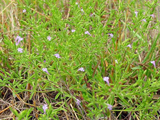Native Plants

Q. Who is Mr. Smarty Plants?
A: There are those who suspect Wildflower Center volunteers are the culpable and capable culprits. Yet, others think staff members play some, albeit small, role. You can torture us with your plant questions, but we will never reveal the Green Guru's secret identity.
Did you know you can access the Native Plant Information Network with your web-enabled smartphone?
Ask Mr. Smarty Plants is a free service provided by the staff and volunteers at the Lady Bird Johnson Wildflower Center.

rate this answer
Wednesday - February 19, 2014
From: Rosanky, TX
Region: Southwest
Topic: Erosion Control, Groundcovers, Grasses or Grass-like
Title: Native plants and grasses for river bank from Rosanky TX
Answered by: Barbara Medford
QUESTION:
Our property owners association would like to know what native plants/grasses to plant on the Blanco River bank in our river park to help prevent erosion. Some banks are steep and some areas are a gradual slope. Members want to know if it is preferable to leave downed trees and flood debris where they fall to prevent future erosion or if the better plan is to remove them and plant new trees and grasses. Our main goals are to protect our riverbank while also making sure property owners have access to enter the river and enjoy the water. Thank you for your help!ANSWER:
To answer your last question first, we would never recommend leaving debris, including fallen trees, on the ground. After all, you are in Bastrop County, and we understand we are already entering a period of Fire Danger warnings in Central Texas. Plus, it would be more difficult to plant and care for groundcovers with that debris present.
You mentioned steep banks but did not tell us about the sunlight available, so we are going to do a combination search on our Native Plant Database for groundcovers - some will be low and some will be high, so you will need to follow each plant link to our webpage on that plant, paying special attention to the growing conditions of each. We will check each to make sure it is native to your area before we add it to the list. Follow each plant link to our webpage on that plant, comparing water needs, size and growing conditions with what you are looking for.
First, some groundcovers that will do all right without too much sun - From a previous Mr. Smarty Plants answer for Austin:
Low groundcovers for part shade to shade in Central Texas:
Carex planostachys (Cedar sedge)
Low herbaceous blooming plants for part shade to shade in Central Texas.
Amblyolepis setigera (Huisache daisy)
Callirhoe involucrata (Winecup)
Calyptocarpus vialis (Straggler daisy)
Chamaecrista fasciculata (Partridge pea)
Dichondra argentea (Silver ponyfoot)
Glandularia bipinnatifida (Purple prairie verbena)
Hedeoma drummondii (Drummond's false pennyroyal)
Now, here are some taller grasses, for varying amounts of sun:
Andropogon gerardii (Big bluestem)
Aristida purpurea (Purple threeawn)
From the Image Gallery
More Erosion Control Questions
Water seepage problems in basement in Philadelphia
April 09, 2009 - I am interested in stopping/limiting water seepage into my basement by placing water absorbing ground plants along one or both sides. The grass we planted when home was new in July 2007 has taken on o...
view the full question and answer
Plants for erosion control in West Mifflin PA
November 23, 2009 - I have recently had a retaining wall rebuilt in my back yard and an above the ground pool installed. My lawn is uneven with no grass and the hillside is very dry dirt with rocks. What type of plant ...
view the full question and answer
Native Streambank Plants for SE Pennsylvania
July 18, 2013 - I help manage a nature preserve in southeastern Pennsylvania. Along the stream the banks have been beaten down by a large number of visitors for their educational activities such as stream studies. Th...
view the full question and answer
Plants to prevent bank erosion in Virginia
April 02, 2009 - I am looking for good native plant choices for a steep river bank. My driveway is at the top of this slope, so I will need to avoid any plants that would cause erosion. I would prefer low shrubs.
view the full question and answer
Plants with color for steep slope in Calera, Alabama
March 26, 2010 - I have a large steep slope in my back yard that the developer called a privacy break. It has poor soil and gets full sun. I have planted muhly and maiden grasses but would like some color. The slope ...
view the full question and answer
| Support the Wildflower Center by Donating Online or Becoming a Member today. |

